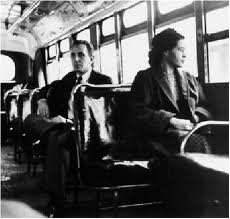|
Moderated by NW Okie! |
Volume 14 , Issue 112012Weekly eZine: (366 subscribers)Subscribe | Unsubscribe Using Desktop... |
The Pioneer Woman of Civil Rights In 1955

This week we remind you of the woman that began the "Civil Rights" movement that most historians date back to 1 December 1955. That was a day when an unknown seamstress in Montgomery, Alabama refused to give up her bus seat to a white passenger. This woman who refused to give up her bus seat was the honorable, inspirational Rosa Parks.
Rosa Parks (known as the "mother of the civil rights movement") was arrested and fined for violating a city ordinance, but her lonely act of defiance began a movement that ended legal segregation in America. It made her an inspiration to freedom loving people everywhere. (The Story Behind the Bus).
Rosa was born Rosa Louise McCauley in Tuskegee, Alabama to James (a carpenter) and Leona (teacher) McCauley. At the age of two Rosa moved to her grandparents' farm in Pine Level, Alabama with her mother and younger brother, Sylvester. At the age of 11 she enrolled in the Montgomery Industrial School for Girls (a private school founded by liberal-minded women from the northern United States). Rosa's mother gave her daughter this advice, "Take advantage of the opportunities, no matter how few they were."
Back in 1955 they did not have a civil rights. It was just a matter of survival, existing from one day to the next. Rosa Parks remembered going to sleep as a girl hearing the Klan ride at night, hearing a lynching and being afraid the house would burn down. Rosa Parks cited her lifelong acquaintance with fear as her reason for her relative fearlessness to appeal her conviction during the bus boycott. Rosa was quoted as saying, "It was more of a relief to know that I wasn't alone."
It was in 1957 that Mrs. Parks and her husband, Raymond moved to Detroit Michigan where Mrs. Parks served on the staff of U. S. Representative John Conyers. After the death of her husband in 1977, Rosa founded the Rosa & Raymond Parks Institute for Self Development. The Institute sponsors an annual summer program for teenagers called "Pathways to Freedom," as the young people tour the country in buses, under adult supervision, leaning the history of their country and of the civil rights movement. In 1996 President Clinton presented Rosa Parks with the Presidential Medal of Freedom. Parks received a Congressional Gold Medal in 1999.
Mrs. Parks spent her last years living quietly in Detroit, Michigan where she died in 2005 at the age of 92. Rosa Parks courage changed the lives of many. She was the only woman and second African American in American history to lie in state at the Capitol, at her death.
The "Jim Crow" laws at the local and state levels barred them from classrooms, bathrooms, theaters, train cars, juries and legislatures. In 1954, the U.S. Supreme Court struck down the "separate but equal" doctrine that formed the basis for state sanctioned discrimination, which drew national and international attention to African Americans' plight.
It was the turbulent decade that followed, civil rights activists used "non-violent" protest and "civil" disobedience to bring about change. The Federal government made legislative headway with initiatives such as the voting Rights Act of 1965 and the Civil Rights Act of 1968.
In 1963, Betty Friedan (founder of the National Organization for Women) published The Feminine Mystique, which exposed the strict and confining gender roles instilled in the U.S. society in the 1950's and 1960's and today. Aa exploration of the white housewife's daily existence, The Feminine Mystique revealed how white girls were socialized to marry and then live vicariously through their husbands and children, without establishing their own identities or interests.
The sexism that was present in the Civil Rights Movement was a continuation of oppressive mentality that existed in the larger U.S. culture, which was and is today a white, male-dominated culture.
In teaching for diversity and social justice, editor Lee Ann Bell argues: "The Civil Rights Movement fired the imagination of millions of Americans who applied its lessons to an understanding of their own situations and adapted its analyses and tactics to their own struggles for equality. For example, Native American, Chicano and Puerto Rican youth styled themselves after the African American youth in SNCC (Student Non-Violent Coordinating Committee) and the Black Panther Party. The predominantly White student antiwar movement drew directly from the experiences of the Black freedom struggles to shape their goals and strategies. Early women's liberation groups were spawned within SNCC itself as black and white women applied the analyses of racial inequality to their own positions as women, as did Latinas within the Puerto Rican Youth. The gay liberation and disability rights movements also credit the Civil Rights Movement as a model for their organizing and activism. Poor people's movements and welfare rights likewise drew upon this heritage.
| View or Add Comments (0 Comments)
| Receive
updates ( subscribers) |
Unsubscribe
| © . Linda Mcgill Wagner - began © 1999 Contact Me | |
